|
by Cyril Lafong
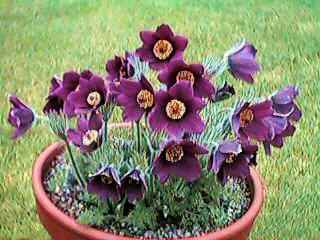
|
Pulsatilla
vulgaris (pasque flower)
Pulsatilla vulgaris is an easy plant for the beginner.
It grows well in the open ground on a variety of soils but flowers best in a
well-drained sunny site. The flower stems, 25-30 cm high, appear in
April-May (Pasque = Easter) and are followed by beautiful seedheads which last
for a long time.It comes in a variety of colour forms from pale to deep purple,
red and pure white. The plant dies down in winter and is quite long-lived
but does not transplant well due to its deep tap root.A helping of bone meal in
the autumn helps flowering. Propagation is easy from seed, especially
sown as soon as ripe.
|
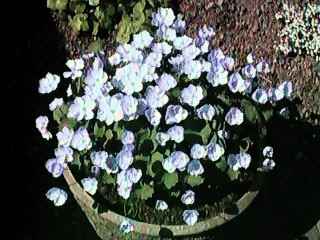
|
Jeffersonia dubia
This is a shade-loving plant from Japan which
grows very well in Scotland as so many woodlanders. It is slow-growing
but in ideal conditions makes a large clump. It does not mind too much
being lifted for showing and after 10 years growth will fit into a 30 cm
pot. This gives an opportunity to add some some good leafy compost when
planting back in the garden. The kidney-shaped leaves are a beautiful
metallic purple when they first unfold but these turn green after a few
days. The lavender-blue flowers appear on 15 cm stems are very
short-lived. Timing is crucial for showing as the plant is at its best
only for a day or two. Propagation is easy from fresly-sown seeds.
|
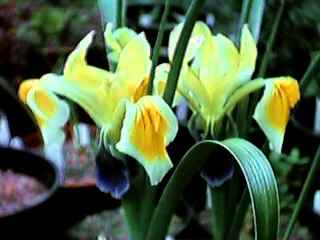 |
Iris fosteriana
This belongs to a group of bulbous irises
with swollen roots known as the Juno irises. Some of the more vigorous
Juno irises, e.g. I. magnifica can be grown easily in the open
garden but I. fosteriana will not tolerate this treatment in Scotland
because it needs to be kept dry in the dormant summer season. Repotting takes
place every year in early November in hand-damp compost (JI No. 3 with added
grit) with only the ends of the swollen roots in contact with the
compost. The rest of the pot is then filled with coarse grit.
Growth takes place in winter with flowering at the end of February usually in
time for the Dunblane early bulb show. It is clump forming and the plant can be
divided at repotting time but it is self-fertile and will set seeds if
pollinated with a fine brush.
|
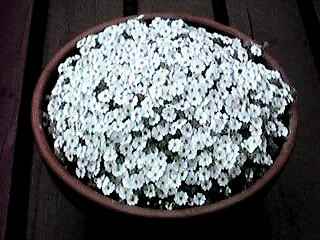
|
Androsace muscoidea CR 188
Some forms of Androsace muscoidea
can make lax cushions with the flowers well clear of the foliage.
The form CR 188 is a neat, compact little plant with comparatively large and
almost sessile white flowers (pink in f. longiscapa) from small hairy
rosettes. It must be one of the best forms of A. muscoidea
although it is not mentioned in the new Androsace book by Smith &
Lowe. It makes a superb show plant. The plant requires protection from overhead
damp in winter and grows best in a very gritty compost in a clay pot plunged in
sand. It flowers early, usually end of March, compared with other forms
of A. muscoidea which flower in early summer. Seeds have been set
recently on mature plants but have not yet germinated.Cuttings will root slowly
if taken at the right time, usually in May.
|
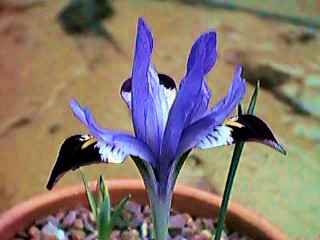
|
Iris kolpakowskiana
This is one of the reticulata bulbous irises.
It is atypical in the section in having 3 or 4 channelled crocus-like leaves
instead of 1 or 2 leaves, square in cross-section of most reticulata irises.
Safest in the alpine house, but not easy to keep going for long, being
particularly prone to rotting. A very gritty but rich compost kept on the dry
side in winter seems to suit it best. Increase by offsets is slow. Has set seed
after cross-pollination. It is reported to grow and increase well in an open
south-facing aspect in Latvia although material is too scarce to try in the
open in Scotland.
|
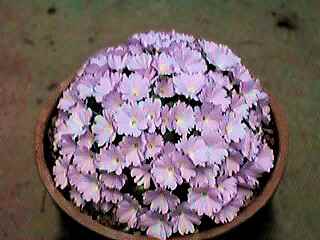
|
Primula allionii 'Anna Griffith
One of the best selections of P.
allionii, flowering in early spring. Cushion forming, it grows very slowly
and takes many years to fill a 15 cm pot. Not too difficult but needs overhead
protection at all times. A mixture of equal parts JI No. 2, composted bark and
grit is suitable with annual repotting after flowering in the early years. The
removal of dead leaves and flowers helps to keep the plant tidy and to prevent
botrytis. Can be propagated by division or cuttings - do not cover.
|
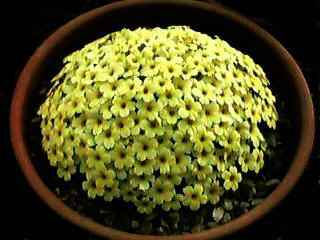
|
Dionysia 'Annielle'
Dionysias are not plant for beginners. Even
experienced growers find most species and hybrids taxing. Dionysia
'Annielle' is a hybrid between DD. curviflora and tapetodes.
The requirements for successful cultivation are:
- clay pot plunged in sand with a gritty compost
consisting of JI, sharp sand, grit, vermiculite. Direct watering in pot rarely
necessary if plunge is kept moist -
alpine house protection all the year round. Sunny aspect with some shading when
the sun is at its fierciest - ample
ventilation, overhead electric fans is an advantage
- not too frequent repotting as the roots are
sensitive to disturbance - a preventative
systemic fungicide sprayed in autumn can be beneficial in a damp climate like
Scotland. |
^ back to the top ^
|

